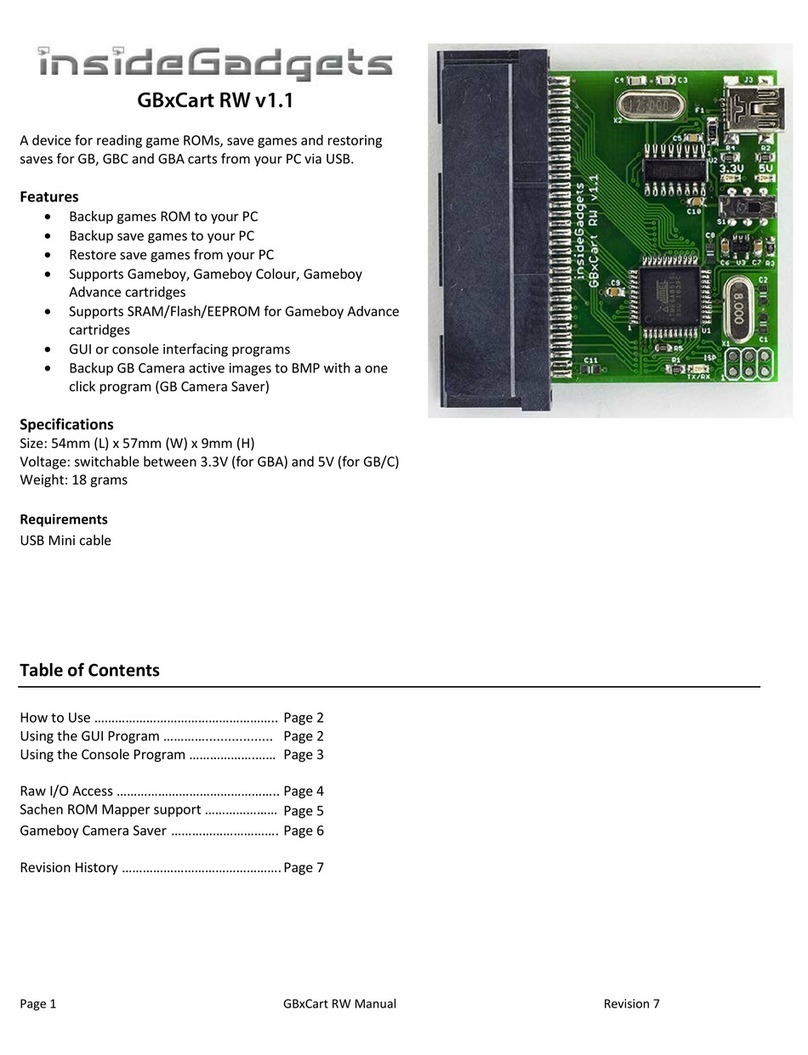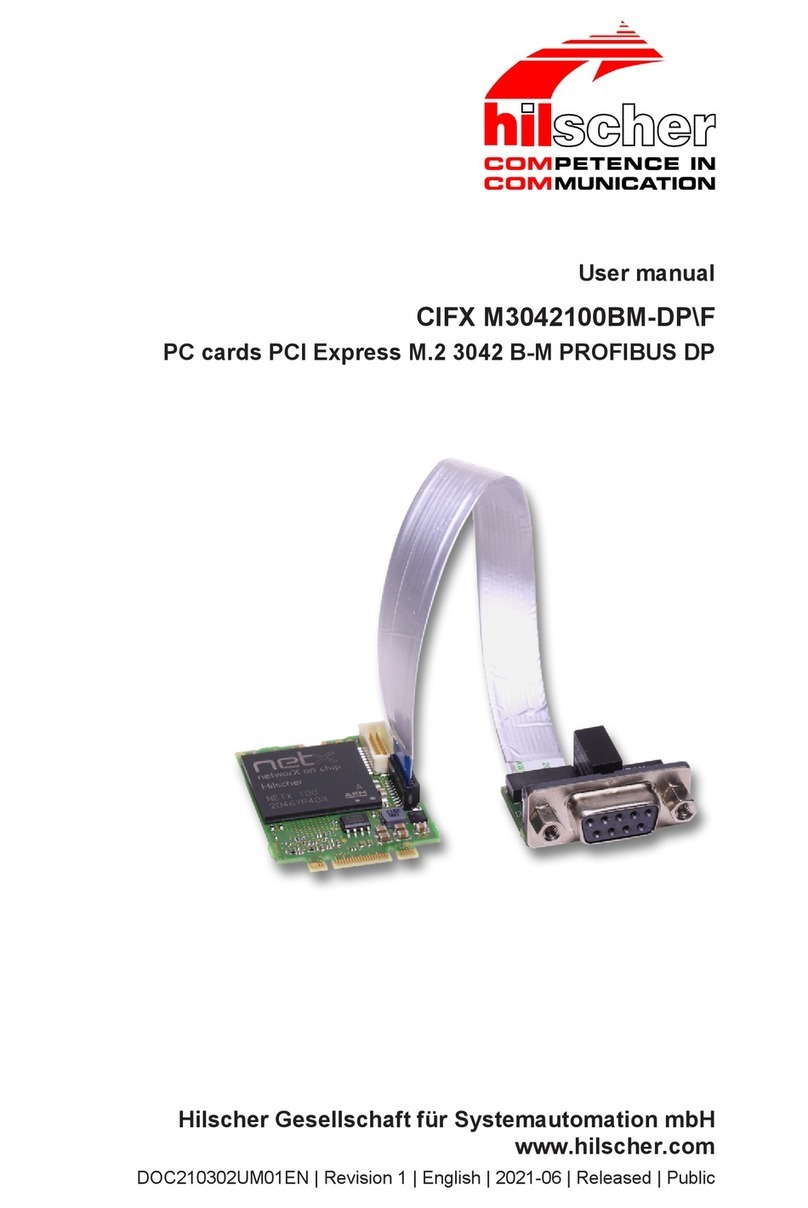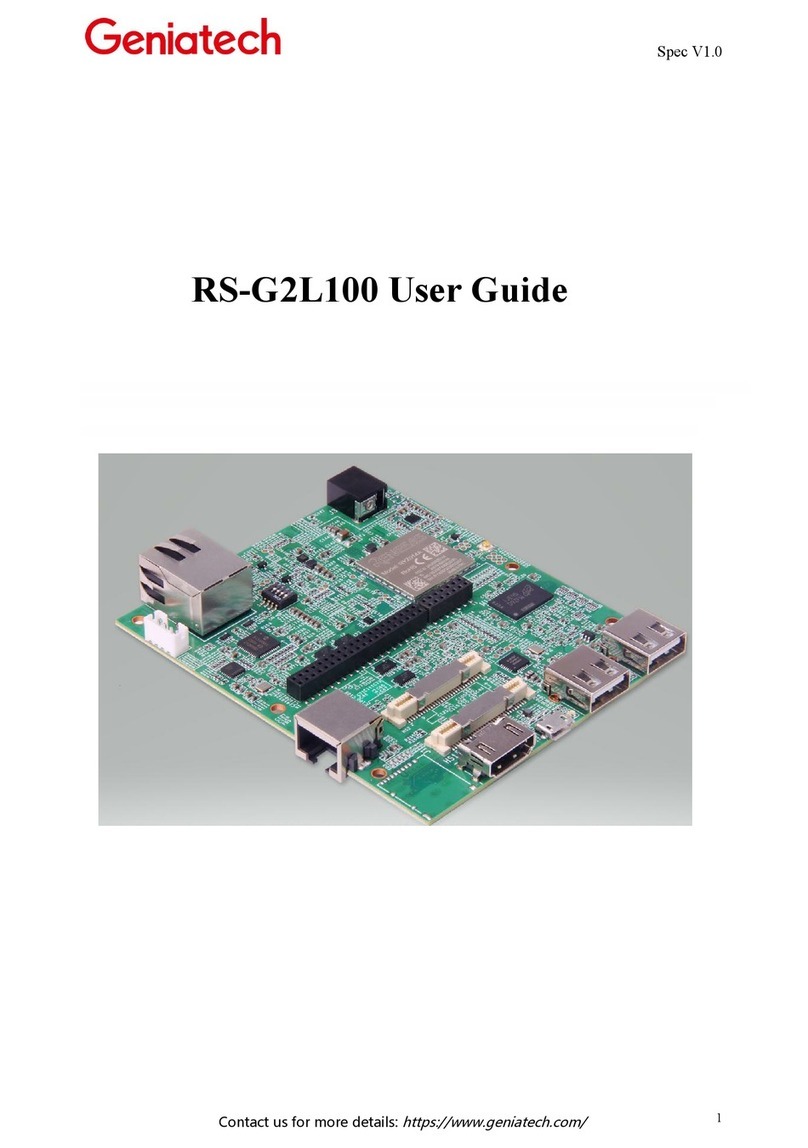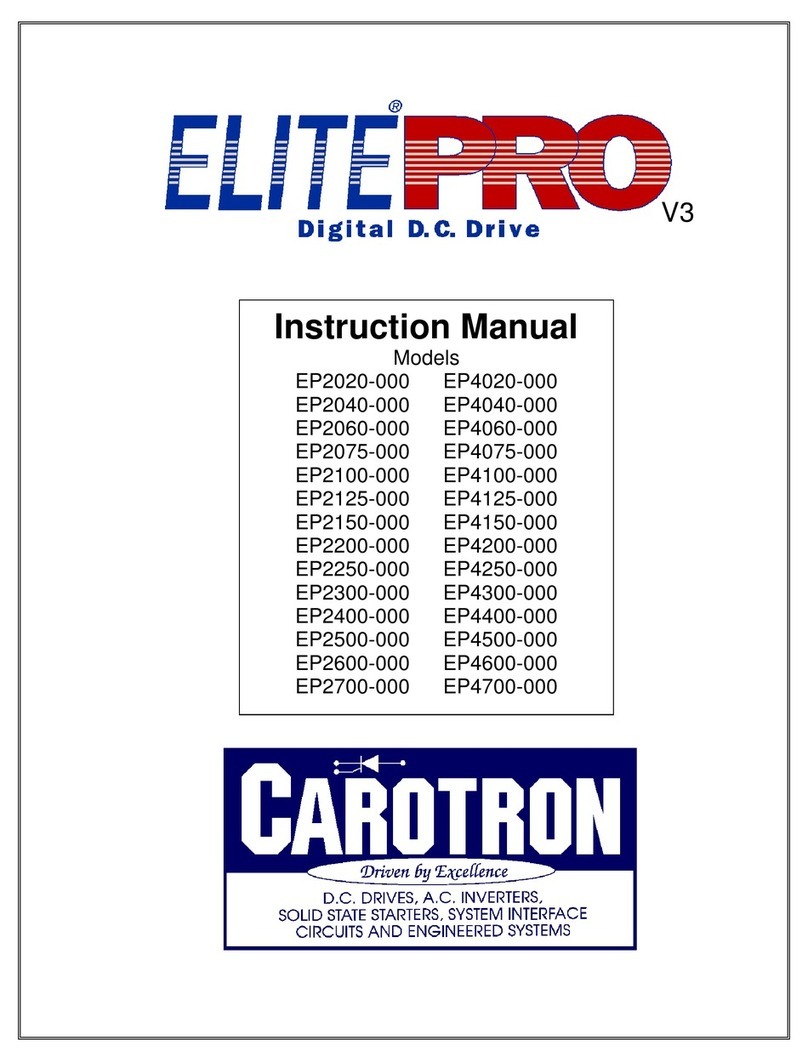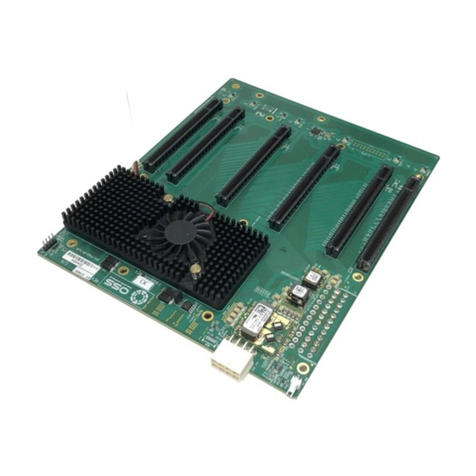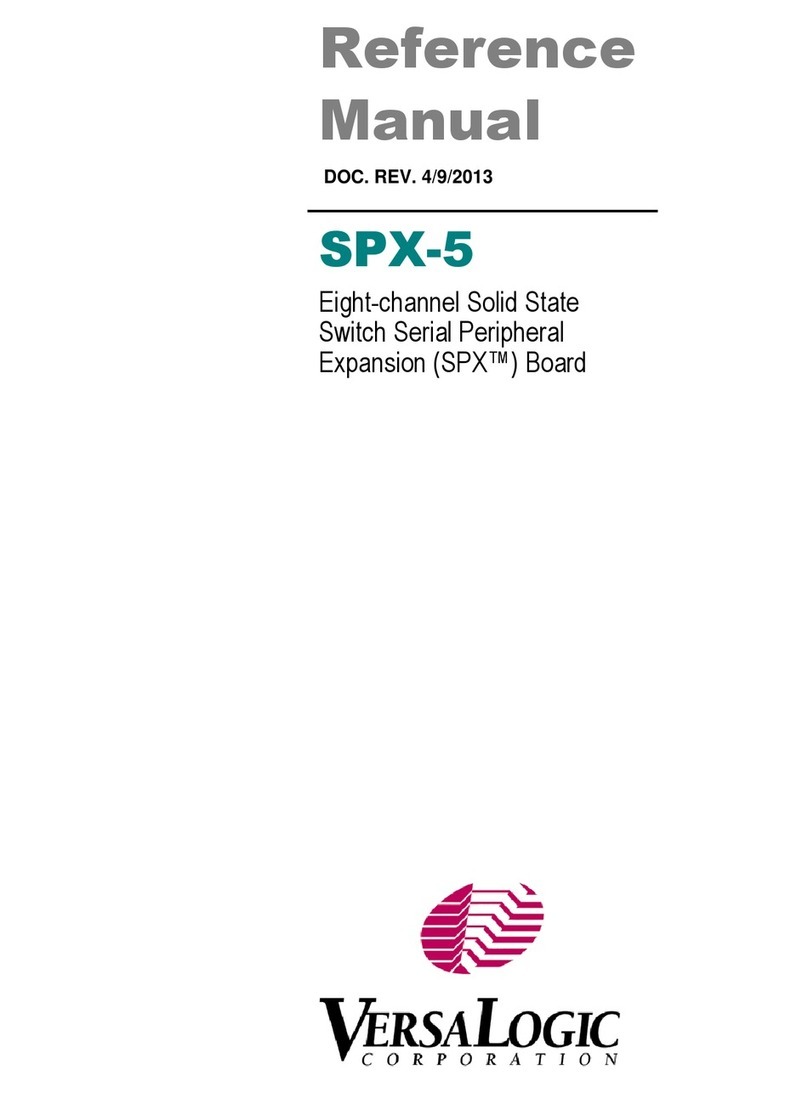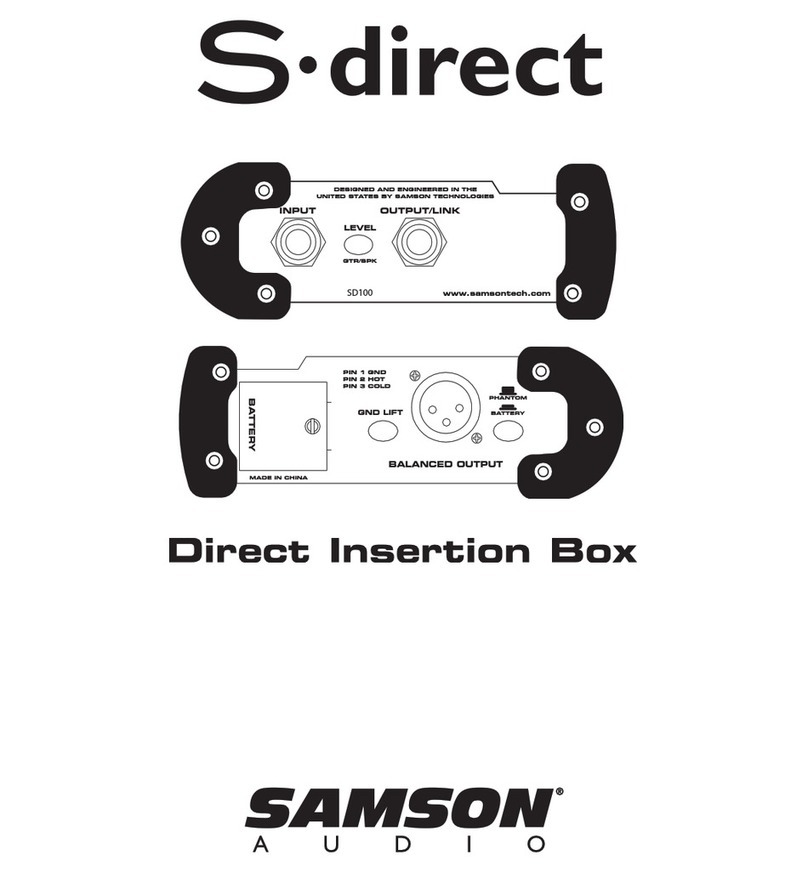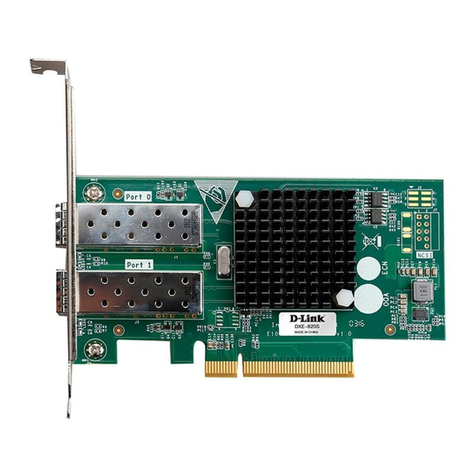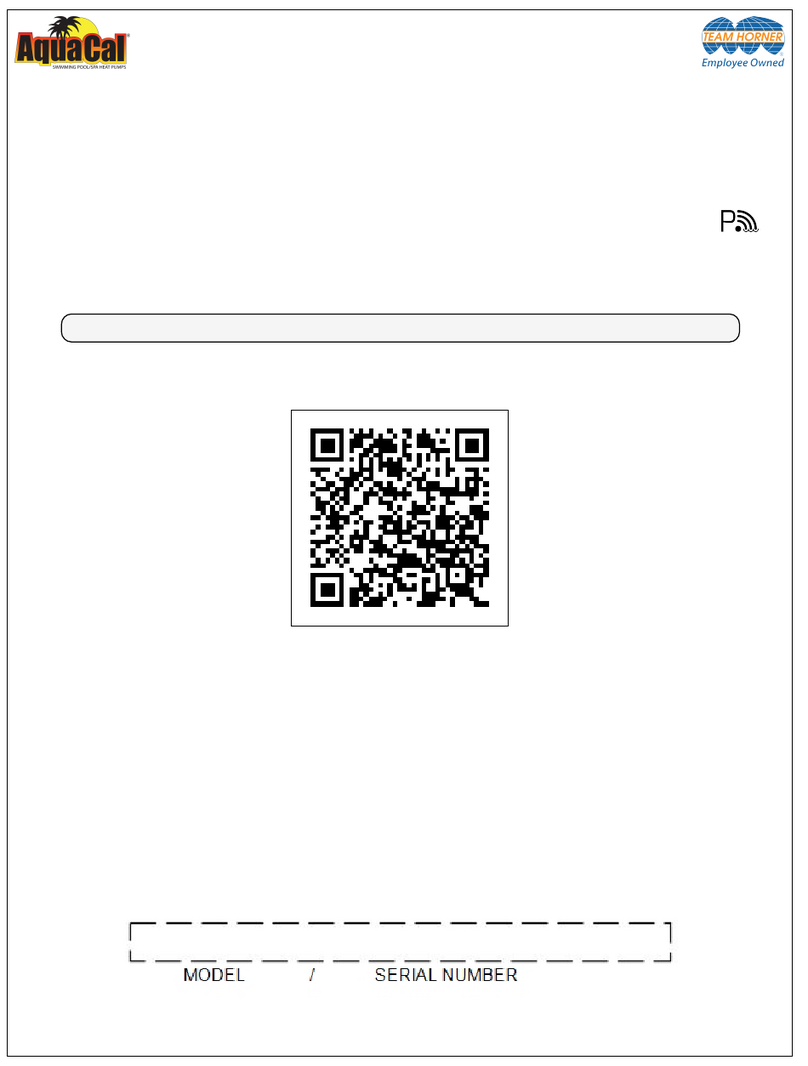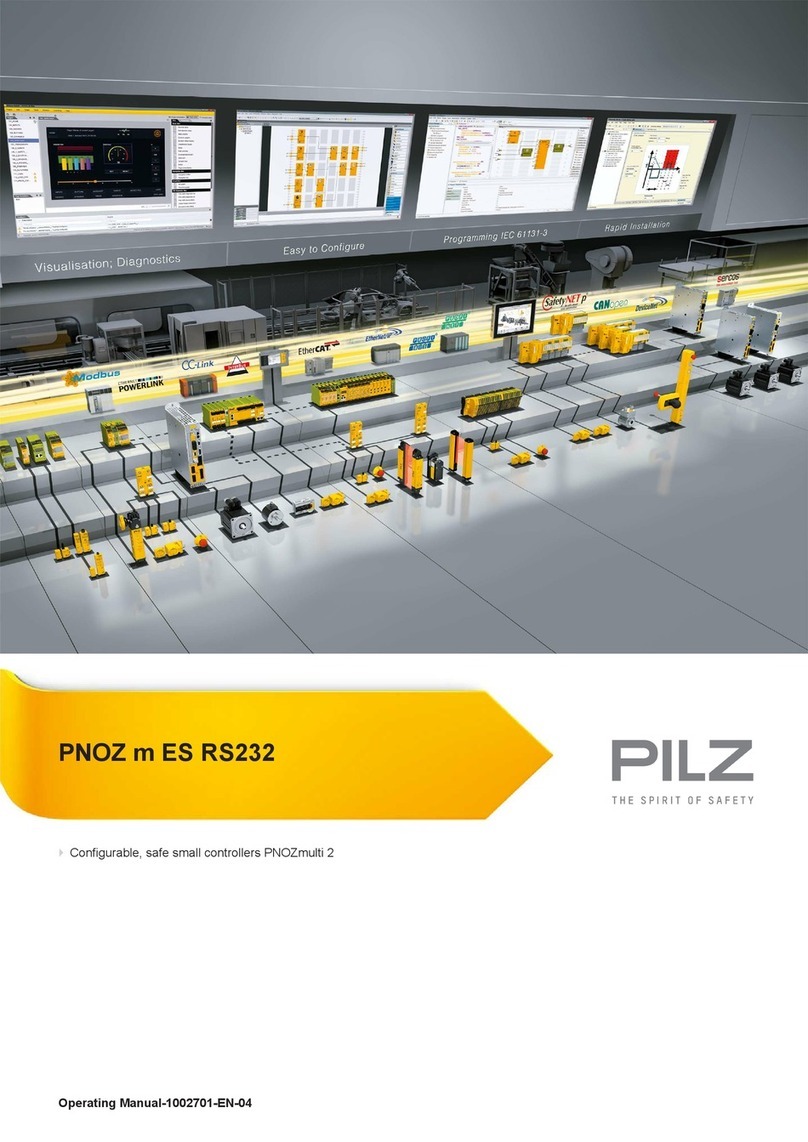EECI AD-16 Use and care manual

TABLE OF CONTENTS
Specifications....................................... page 1
Technical Support and Warranty ........ page 1
Connection Diagram and RCT-8.......... page 2
Set-Up, Testing & Trouble-Shooting..... page 3 & 4
Temperature Input................................ page 5
Input Amplification and Conditioning..... page 6
Differential Input & Optocouplers.......... page 6
Voltage Reference Inputs..................... page 7
Analog Inputs and Interfacing............... page 8
10 Bit Analog Inputs............................. page 10
Control Software................................... page 11
Programming Examples......................... page 11
Rack Mounting....................................... page 12
Use of Mounting Panels......................... page 12
Repair Service....................................... page 12
SPECIFICATIONS
Power Supply....................... 5 volts DC (powered thru RC-20 ribbon cable to AR-8X, ADC-16 OR STA-16)
Operating Temp. Range...... -40° C to +85° C
Analog Inputs....................... 16 or 32 single-ended inputs (standard 8 bit resolution or optional 10 bit resolution)
(8 bit resolution will divide your measurement range into 256 different increments)
(10 bit resolution will divide your measurement range into 1,024 different increments)
Weight................................. 3.5 ounces
Size...................................... 7 inches by 5 inches
Options Available................. 10 Bit Resolution
Temperature Input
TECHNICAL SUPPORT
Technical support for our products is available by calling (937) 349-6000. If a technical adviser is not available,
please leave your name, phone number and a time that you can be reached. Your call will be returned as soon as
possible and within 24 hours. Before contacting technical support be sure that you have your PC and interface
hardware powered up with a telephone at hand. The interfacing hardware (ADC-16, ST-32, etc.) should not be inside
an enclosure and should be immediately accessible. A multimeter should be available for checking voltage levels and
the test software provided with your hardware should be ready to run.
WARRANTY AND CARE OF THE AD-16
The AD-16 Analog to Digital Converter is warranted against factory defects for a period of 90 days from the date of
purchase. The AD-16 has proven to be extremely reliable in actual operation during field tests. We recommend that
the AD-16 and associated hardware be installed in a suitable enclosure (4 mounting holes are provided on the circuit
board) and that reasonable precautions be taken to protect the circuit from static discharge. The most likely damage
to occur is that caused by lightning discharge through the power supply or serial I/O lines. The best way to prevent
this type of damage is to install a Power Protector (Part # SP-120 or Radio Shack #26-1395 or Surgebuster
#120K15A) in the electrical outlet which supplies power to the hardware. Sheilding the analog input lines will provide
additional protection. If further protection is desired, install a TransZorb* across the power input to the interface card
(part #SP-12K) and to the RS-232 lines (part #SP-232K). *the ADC-16 may be ordered with TransZorb (T option)
Page 1
TECHNICAL REFERENCE
AD-16 AD-32
ANALOG TO DIGITAL
EXPANSION CARD
PHONE*.................
ORDERS................
TECH SUPPORT...
E-mail*....................
Web*........................
*International & Domestic
(937) 349-6000
(800) 842-7714
(937) 349-6000
http://www.eeci.com
ELECTRONIC ENERGY CONTROL, INC.
14960 Maple Ridge Rd
Milford Center OH 43045-9016
USA

POWER SUPPLY REQUIREMENTS
The ADC-16 may be powered from any DC voltage source which will supply 300 ma within a voltage range of 9 to 14
volts. The recommend power supply for use with a single ADC-16 card is the PS-GP-1 (wall transformer supply).
IMPORTANT: Use caution when connecting the power source, reversed polarity may cause damage. The heat
dissipation of the 7805 regulator on the ADC-16 will be greatly reduced with a 9 volt power source. The PS-9VDC-500
and PS-9VDC-1000 wall transformer power supplies may be used to power both the ADC-16 and expansion card(s)
without the need for additional regulators. Please note that the PS-12VDC-500 and PS-12VDC-1000 are unregulated
supplies and may produce voltages as high as 18 volts (see pages 7 & 8).
POWER SUPPLY FUSING: A 500 milliamp (.5 amp) in-line fuse should be installed in series with the (+) power supply
lead to protect the power supply and the ADC-16 from damage.
SET-UP AND TESTING
Upon receiving your ADC-16, you should connect and test the operation of the hardware to verify proper operation.
Please set-up and test the ADC-16 as follows (IBM and Compatibles):
(1) Plug the serial cable into COM 1 of your computer and connect the other end to the terminal block on the ADC-16
(as shown on page 2). If you did not order a serial cable, a cable may be fabricated by soldering the wires to the
proper connector as shown on the following pages. Care should be taken to prevent any static discharge on the ADC-
16 by touching a metal ground before handling the ADC-16 and associated circuits. Use caution not to set the ADC-16
or associated hardware on a metal surface or damage could result.
(2) Connect the power supply (part # PS-GP-1) to the six position terminal block at the bottom of the ADC-16. Be sure
to observe the (+) and (-) connections on the ADC-16 (reversed polarity may cause damage). Connect the RTC-16
terminal block to ports #1 and #2 on the ADC-16. When connecting the ribbon cable from the RCT-16 to the ADC-16,
the red line on the ribbon cable should be positioned as shown on page 2. The ribbon cables for the RTC-16 should be
routed underneath the ADC-16 so that the RCT-16 is on the right side of the ADC-16.
(3) The ADC-16 is set to 19,200 baud at the factory. This is the proper setting for use with the test software which is
provided on disk with your order.
NOTE: If any of the analog ports have been configured for temperature input, skip
this section and complete the set-up and testing requirements which are described in the TE-8 technical reference.
Install the ADC-16 application by clicking on the Install MS .Net App and run the App.
Your screen should show a row of 8, 16, 32 or 48 numbers. The first 8 numbers represent the analog inputs for port #1
and the second 8 numbers represent the analog inputs for port #2. The additional rows represent the analog inputs for
the AD-16 or AD-32 (you may need to check the box below the row the enable the inputs).The numbers may be
fluctuating as a result of noise on the analog inputs (this is normal).
(4) Test each analog input by connecting each input (one at a time) to the reference (-) terminal on the RCT-8 or RCT-
16 (see page 4). Your screen should show a "0" for that input. After this is completed, connect each input (one at a
time) to the reference (+). Your screen should show a "255" for 8 bit inputs or "1023" for 10 bit inputs for each input. If
Page 3
CONNECTION DIAGRAM
A D - 3 2 A N A L O G TO
D I G I T A L C O N V E R T E R
.
Page 2
ALL RIBBON CABLES MUST
BE INSTALLED WITH THE
NOTCH POINTING UP
(red conductor should be
positioned as shown)
AD-16 I/O PORT
connect to AR-8X, ADC-4,
ADC-8, ADC-16 or STA-16
ANALOG INPUT PORT #A
to connect inputs 17 thru 24
ANALOG INPUT PORT #B
to connect inputs 25 thru 32
J1
J2
J4
J3
RED
RED
RED
RCT-8
Analog Input #1
Analog Input #2
Analog Input #3
Analog Input #4
Analog Input #5
Analog Input #6
Analog Input #7
Analog Input #8
(+ Reference)
(- Reference)
Red Line
Ribbon Cable to
ADC-16
ANALOG INPUT PORT #D
to connect inputs 41 thru 48
ANALOG INPUT PORT #C
to connect inputs 33 thru 40
RED
RED

(4) The input voltage to any of the analog inputs must not exceed the reference voltage (nor should the input go
negative with respect to the reference) or erratic data may be generated on one or more of the analog channels.
When an external reference is used, the reference voltage must be within 100 millivolts of the supply voltage to the
ADC0809 IC (approximately 5 volts DC) when operating in a MODE (2) jumper configuration (see pages 10 & 11).
When operating in a MODE (3) jumper configuration (8 bit only), the reference voltage must be a minimum of 1.2
volts and the reference voltage must be centered about the supply voltage to the ADC0809 IC. When operating in a
MODE (3) jumper configuration, the input voltage to any of the analog inputs must not exceed the reference voltage
(nor should the input go negative with respect to the reference) or erratic data may be generated on one or more of
the analog channels. If after checking thoroughly you are still unable to correct the problem, contact us at (937) 349-
6000 for technical support.
OPTIONAL TEMPERATURE INPUTS FOR THE ADC-16 AND ADC-8
The ADC-16, AD-16 and AD-32 may be configured for temperature input by specifying the E and/or F options when
ordering the ADC-16. The inputs are converted to temperature in groups of eight. The ADC-16 may be ordered with 8
temperature inputs and 8 analog inputs or with all 16 channels converted for temperature input. The 8 bit inputs
require that a voltage reference and several additional components be installed on the ADC-16 card. Once the 8 bit
inputs have been converted for temperature input, the analog input port (all 8 channels) will be dedicated for use as
temperature input only. When the ADC-16 or ADC-4 is equipped with 10 or 12 bit inputs, additional components are
not required for temperature input. The 10 bit inputs are converted to temperature input by connecting the TE-8
temperature input card to the 10 bit analog input port (removal of the TE-8 from the ADC-16 allows the inputs to be
used for conventional analog input). The temperature error of the TE-8 is typically less than 1 degree F. Greater
accuracy may be obtained with the use of the extended range temperature sensors. The temperature input ranges
for 8 and 10 bit inputs are as follows:
(8 bit inputs) temperature range -40° F to 146° F (-40° C to 64° C) standard sensors
(10 bit inputs) temperature range -40° F to 212° F (-40° C ro 100° C) standard sensors
(10 bit inputs) temperature tange -67° F to 302° F (-55° C to 150° C) extended range sensors
Page 5
additional testing is desired, connect a 10k ohm 20 turn potentiometer to each input (one at a time) as shown on page
12, figure B. The input shown on the screen should increment from 0 to 255 (8 bit) or 0 to 1023 (10 bit). The number
shown for each input should increment by one (in 256 increments for 8 bit inputs) or (in 1024 increments for 10 bit
inputs) as the potentiometer is slowly adjusted from 0 to 20 turns.
(5) If operation of the analog inputs are normal, then testing is now complete and your ADC-16 may be placed in
service. If problems are encountered during testing, proceed to the trouble-shooting procedures shown below.
NOTE: The (S) terminal on the ADC-16 is provided for use as an RS-232 control signal for use with the RS-232 control
lines CTS, DSR and DCD. If the ADC-16 does not function with your software, connect the (S) terminal (black wire) to
all three control lines (CTS, DSR and DCD). The pins for these control lines on a DB-25 connector are pins 5, 6 and 8.
The (S) terminal may also be used to supply a signal to one of the RS-232 control lines for use as a supervisory signal
to sound an alarm with your software when the ADC-16 has lost power or has been disconnected (see utilities).
RCT-8 CONNECTION DIAGRAM
TROUBLE-SHOOTING THE ADC-16
(1) Verify power to the ADC-16 by checking for 5 volts DC on the 2200 mf capacitor (low voltage may indicate an
overload). Verify that the ADC-16 is set to the same baud rate as what appears on the test software screen. Check for a
minimum of 9 volts DC at the ADC-16 power input (on the 6 position terminal block) and check for correct polarity. The
RS-232 driver on the ADC-16 requires a minimum of 9 volts for proper operation. A voltage over 14 volts will cause
damage to the RS-232 driver.
(2) Verify proper operation of the serial port (RS-232 port) on your computer. You may check your COM port by going to
Control Panel/Device Manager and expanding the Ports category.
(3) If erratic operation is experienced, check for loose connections at the ribbon cable connections and terminal block
(tug on each wire going into the terminal block), check for power supply interruptions or short circuits caused by metal
contact to the ADC-16 circuit areas or other connected hardware. When more than three EX-16 cards are connected to
the ADC-16, an external power feed is required (see EX-16 manual).
Page 4
RCT-8
Analog Input #1
Analog Input #2
Analog Input #3
Analog Input #4
Analog Input #5
Analog Input #6
Analog Input #7
Analog Input #8
(+ Reference)
(- Reference)
Red Line
Ribbon Cable to
ADC-16
NOTE: The RCT-16 will
have the same connections
as two RCT-8

VOLTAGE INPUT AMPLIFICATION AND SIGNAL CONDITIONING
The ADC-16 defaults to a 0 to 5 volt input range (installation of a voltage reference will allow input ranges as low as 0 to
1.2 volts when using 8 bit inputs). When the input voltage range is required to be lower, (such as with a watt transducer
or laod cell) an external instrumentation amplifier must be used to amplify the input signal to the 0 to 5 volt input range
of the ADC-16.
Several general purpose instrumentation amplifiers are available to amplify lower signal levels to the 0 to 5 volt range
required by the ADC-16 (for use with 8, 10 and 12 bit inputs). The VA-1 is a single channel amplifier for connection to
the ADC-4, ADC-8 or ADC-16. The VA-2, VA-4 and VA-8 amplifiers are two, four and eight channel versions of the
VA-1. The VA-1, VA-2, VA-4 and VA-8 all provide 15 turn potentiometer(s) for gain adjustment (amplification level). The
amplification level is adjusted for a 0 to 100 millivolt input at the factory. The amplification level may adjusted for signal
inputs as low as 0 to 5 millivolts or as high as 0 to 5 volts. Lower signal levels (such as the output signal from a watt
transducer, pressure transducer, load cell, etc.) with typical full scale voltages of only 20 to 100 millivolts will require the
addition of the VA-1 instrumentation amplifier. Signal levels this low will require shielded wire in place of a twisted pair.
The shield should be left disconnected at the source and grounded to an earth electrical ground at the VA-1.
CONNECTION OF DIFFERENTIAL SIGNALS: The ADC-16 inputs are single-ended. If differential inputs are required,
the VA-1 may be used to convert a differential signal into a 0 to 5 volt signal for connection to the ADC-16. The VA
series amplifiers have a reference input (for connection to the ADC-16 reference) which is used to generate a 2.5 volt
offset. The gain adjustment on the VA series amplifiers may be adjusted to allow for differential signals as low as (+)
and (-) 5 millivolts or as high as (+) and (-) 5 volts.
ANALOG LINEAR OPTOCOUPLERS: The VI-1I or VI-8I linear optocoupler instrumentation amplifiers may be used
when the analog input signal must be electrically isolated (such as with some types of pressure transducers, signals
with ground referenced offsets or for signals which must be isolated for safety).
VOLTAGE REFERENCE INPUT
Each 8 channel analog input port has a separate voltage reference input and each port may be selected to function in
any of the following three modes. NOTE: 10 bit inputs are limited to a 5 volt reference.
MODE (1).....Voltage reference equals power supply. With the factory jumpers installed, the reference (+) and
reference (-) will be equal to the power supply voltage (5 volts and ground, plus or minus .25 volts). The voltage input
scale will be 0 to 5 volts (20 millivolt resolution with 256 increments for 8 bit inputs or 5 millivolt resolution with 1,024
increments for 10 bit inputs). The ADC-16 will then transmit (255)* with a 5 volt input, (0) for a 0 volt input, (128) for a
2.5 volt input and other values corresponding to the following formula: voltage times (51) = X, where X = the integer
value transmitted. EXAMPLE: 1.9 volts times 51 = 96.9. The ADC-16 would then transmit (97) decimal (in binary) to
represent a 1.9 volt analog input. The use of the power supply for the voltage reference will be adequate for most
applications. MODE (1) is selected when both jumpers are installed (J1 and J2 for port #1, or J3 and J4 for port #2), all
8 channels of the analog port will then function in the MODE (1) configuration. *binary number represented in decimal
MODE (2).....Voltage reference equals calibrated external voltage reference equal to power supply voltage. This
method will provide a greater degree of accuracy for analog inputs which need to be referenced to the actual volt (use
of the power supply for actual volt reference may introduce small errors due to variations in the power supply caused by
activity of the ADC-16 functions). To select the MODE (2) configuration cut the (+) reference voltage jumper (J1 for port
#1 or J3 for port #2). The jumpers to the (-) reference voltage should be left in place (J2 for port #1 or J4 for port #2). A
calibrated voltage equal to the ADC-16 power supply (plus or minus .1 volt) should be applied to the voltage reference
input (terminal #9 (+) and #10 (-) on the RCT-8). The voltage input may be any well regulated power supply which can
be adjusted to the desired voltage without drift (for greater stability a temperature compensated power supply may be
used). To determine the proper voltage, measure the ADC-16 power supply voltage on the 28 pin 0809 chip (pins #11
and #13). The resolution will be equal to the reference voltage input divided by 256. All 8 channels of the analog input
port will then function in the MODE (2) configuration with J1 (port #1) or J3 (port #2) cut and the external voltage
reference connected. The ADC-16 has the capability of providing an on-board voltage reference by installing a
Page 6
317 adjustable voltage regulator, 500 ohm trimmer, 240 ohm and 390 ohm resistors on the top right side of the ADC-16.
MODE (3).....(8 bit only) Adjusted voltage reference input. In this mode of operation the voltage input level may be
adjusted to allow input of lower analog voltages (down to about 1.2 volts full scale). The MODE (3) configuration is
selected by removing the voltage reference jumpers (J1 and J2 for port #1 or J3 and J4 for port #2) and installing a
limiting resistor (3K typical) in place of both jumpers. It is important that both resistors be installed because the
reference voltage must be centered about the supply voltage of the 0809 chip. Conversion errors may occur (due to the
design of the 0809 chip) if the center of the reference voltage is not equal to the center of the supply voltage (plus or
minus .1 volt). The voltage reference device is then connected to the voltage reference input (terminal #9 (+) and #10 (-
) on the RCT-8). The voltage reference may be soldered directly to pins #12 (+) and #16 (-) on the 0809 chip for greater
stability. The voltage reference device may be a simple zener diode or LED for less critical applications (use (2) 180
ohm resisters in place of jumpers for LED). When the voltage reference is 2.5 volts or less, the installation of a 470 mf
capacitor on the ADC-16 is recommended (holes are provided near the center of the card above J3 with the positive
lead marked). The use of a temperature compensated voltage reference will result in greater accuracy and less drift.
You may contact our technical support staff for more information on the voltage references which we stock.
NOTE: The analog voltage input must not be higher than the ADC0809 power supply voltage for modes 1 and 2 or the
rated voltage of the voltage reference device for mode 3. In all cases the input voltage must not go negative (or
negative with respect to the reference in the case of MODE (3) operation). Failure to observe these voltage input
restrictions may result in erratic or incorrect conversion results on one or more of the analog channels.
ANALOG VOLTAGE INPUTS
Voltages up to hundreds of volts may be divided down to the 5 volt range by using a simple resistance divider as shown
on the following page (the signal source must be capable of driving a 1 ma load). To determine the value transmitted by
the ADC-16 for a specific voltage applied to the divider circuit use the following formula: (VI divided by DF) times 51 =
TV (where TV = transmitted value sent by the ADC-16, VI = voltage input to divider, DF = divider factor) DF = full scale
voltage divided by 5 volts. EXAMPLE: 100 volts full scale divided by 5 = 20 = DF. A 60 volt input to the divider divided
by 20 multiplied by 51 = 153 = TV, the value transmitted by the ADC-16.
The voltage input source may be located up to several hundred feet from the ADC-16. The RCT-8, RCT-16 or RCP-8
are used to make the wire connections. The wire which connects the RCT-8 to the signal source should be a twisted
pair to reduce possible input noise (22 or 24 gauge communication cable typical). Shielded cable may be used to
further protect against EMI or lightning noise (the shield should be left disconnected at the source and connected to an
earth ground/equipment ground at the ADC-16).
Lower millivolt signal levels (such as the output signals from a watt transducer, pressure transducer, load cell, etc.) with
typical full scale voltages of only 20 to 100 millivolts will require the addition of the VA-1, VA-2, VA-4 or VA-8
instrumentation amplifier. The VA-1 connects to any of the analog inputs and will convert a millivolt signal input to a 0 to
5 volt output for input into the ADC-16. Signal levels this low will require shielded wire in place of the twisted pair. An
adjustment on the VA-1 will set the input scale. The shield should be left disconnected at the source and grounded to
an earth ground at the VA-1. Applications requiring isolated analog inputs require the VI-8I linear optocoupler amplifier.
NOTE: When the analog inputs are left floating, (no connection) the ADC-16 will transmit fluctuating numbers as a
result of noise present at the inputs. We recommend that any unused inputs be connected to reference (-) to prevent
possible errors on other channels.
FILTERING INPUT NOISE: A .01 mf filter capacitor installed on the ADC-16 card (one for each channel) will
significantly reduce errors and fluctuation as a result of input noise (if noise is a problem). Holes are provided on the
ADC-16 for the installation of the .01 mf capacitors (specify part # CAP-16 to order a package of (16) .01 mf filter
capacitors). A 2.7 mf or 10 mf tantalum capacitor may added for additional filtering (input response time will be slower).
Shown on the following page in figures A, B & C are methods for reading contact closure, potentiometer movement &
light levels.
Page 7

IMPORTANT: The full scale voltage used should be the highest possible voltage that could be present at the high
voltage input.
AC voltages may be applied to the high voltage input if a diode is connected in series and a filter capacitor (100 mf,
35 volt typical) is connected between the ADC-16 analog input and the ADC-16 reference (-). AC voltages over 24
volts or great enough to create an electrical shock hazard or fire should be connected to the ADC-16 analog input
using a step-down transformer to reduce the high voltage down to the 5 volt range as shown in figure D. A diode and
filter capacitor must be connected on the secondary side of the transformer (a common low current power
transformer may be used).
10 BIT ANALOG INPUTS
The 10 bit option of the ADC-16 functions very similar to its 8 bit counterpart with the exception of the following:
(1) Input voltage range should be maintained at 0 to 5 volts DC (5.0 volts across the voltage reference inputs).
(2) The ADC-16 will transmit in two byte format as opposed to the single byte format of the 8 bit. The first byte
received will be the most significant digits (all eight bits are used). The second byte received will be the least
significant two digits (the first 6 bits will always be zero and are not used).
(3) The sampling rate of the 10 bit version will be less than half that of the 8 bit as a result of the two byte format
of the 10 bit converter (approximately 500 samples per second for a single channel at 19,200 baud).
Listed below is a software example in GW Basic/Quickbasic. Program examples in Visual Basic, GW Basic,
Quickbasic, C# and Turbo C are provided on the disk supplied with your order. To test the 10 bit converter, insert the
disk in your disk drive and
enter the following:
ADC-8G (ADC-8 port #1 = 10 bit)
ADC-16G (ADC-16 port #1 = 10 bit, port #2 = 8 bit)
ADC-16GH (ADC-16 port #1 = 10 bit, port #2 = 10 bit)
10 '-----------10 BIT ANALOG TO DIGITAL----------- 2-11-93
20 CLS
30 ON ERROR GOTO 330
40 OPEN "COM1:19200,N,8,2,DS,CD,CS" AS #1 'set protocol
50 FOR A=0 TO 8
60 B=A
70 IF A=8 THEN B=0 'synchronize
80 PRINT #1,CHR$(A+15); 'start conversion
90 GOSUB 290:X$ = INPUT$(1,1) 'clear buffer
100 PRINT #1,CHR$(B); 'transmit channel code
110 GOSUB 290:A$ = INPUT$(1,1) 'receive MS byte
120 PRINT #1,CHR$(B); 'transmit channel code
130 GOSUB 290:B$ = INPUT$(1,1) 'receive LS byte
140 Z=ASC(A$)*4 'position MS byte
150 Y=ASC(B$) AND 128 'check bit 8 on LS byte
160 X=ASC(B$) AND 64 'check bit 7 on LS byte
170 IF Y>0 THEN Z=Z+2 'position bit 1
180 IF X>0 THEN Z=Z+1 'position bit 0
190 Z(A)=Z 'store data in array
200 NEXT A
210 IF EOF(1) = -1 THEN 230 'byte in buffer?
220 X$=INPUT$(1,1):CLOSE:GOTO 40 'clear buffer
Page 9
HIGH VOLTAGE INTERFACING
CAUTION: When working with high voltages, the potential for fire, explosion, electrocution, eye injury or blindness
and life threatening injurys or death exists. If you are not familiar with the precautions needed when working with high
voltages, do not attempt to connect high voltage up to these circuits. To prevent the danger of a high voltage feeding
back to the ADC-16 and the fire/injury/electrocution hazard caused by an open or short circuit, a 10 volt 5 watt zener
diode and 1/4 amp fuse should be connected as shown in figure E. Wire used to interconnect a high voltage input
must be rated for use with the higher voltage. When connecting the ADC-16 to high voltage AC equipment the
method shown in figure D above is recommended.
The following method is used to divide a high voltage down to the 5 volt range needed for input into the ADC-16. This
method involves the use of two resistors (R1 and R2) which together add up to Rt (total resistance). The total
resistance is determined by using the Ohms Law to compute the resistance needed for a 1 milliamp current flow
through the resistors. EXAMPLE: If your full scale voltage is 100 volts (R = E divided by I) 100 volts divided by .001
amp = 100,000 ohms (100K ohm). To determine the proper ratio, divide 5 volts by the full scale voltage. 5 divided by
100 volts = .05. Multiple this ratio by the total resistance to determine the value of R2. R1 is then equal to the
difference between the total resistance and R2. EXAMPLE: ratio .05 times total resistance 100,000 ohms = 5,000
ohms (the value of R2). Total resistance 100,000 ohms less R2 5,000 ohms = 95,000 ohms (the value of R1). To
determine the power rating needed for the resistor, use the following formula: P = I squared times R. EXAMPLE: .001
squared = .000001 times R1 95,000 ohms = .095 watts. A 1/8 or 1/4 watt resistor would be sufficient.
Page 8
Fuse or Limiting Resistor (330 ohm 1 watt)
1 Amp Diode (50 volt)
AC Primary Voltage
120, 277, 480 etc.
(-)
6 or 12 Volt
Secondary
100 mf
35 volt
24 ga Communication Cable
To Analog
Input
To Analog
Input
(+)
(-)
10 Volt 5 Watt
Zener Diodes
1/4 Amp Fuse
Diode
(+)
High Voltage
AC/D C Input
(-)
Ground for
Safety
R1
R2
(1 ma maximum current
through resistors)
(+)
R1
R2
100 mf
35 volt
+
FIGURE C
FIGURE D
Switch or Relay
Contacts etc.
(Reference +)
To Analog Input
(+)
10 K ohm
(Reference -)
DIGITAL INPUT
(0=OFF)
(255=ON)
FIGURE A
(Reference +)
(Reference -)
To Analog
Input
POTENTIOMETER
MOVEMENT SENSING
FIGURE B
Ref (-)
To Analog Input
Ref (+)
27K Ohm
Cadmium Sulfide
Photo Cell
+
10 mf Tantalum Capacitor
USING AN ANALOG INPUT
FOR ON/OFF STATUS MEASURING LIGHT LEVELS
FIGURE E
10K OHM
TYPICAL

230 LOCATE 1,1
240 FOR X=1 TO 8
250 PRINT Z(X);" " 'print on screen
260 NEXT X
270 GOTO 50 'repeat
280 '------------------subroutine to check for byte-------------------
290 C=0
300 IF C>5000 THEN CLOSE:CLS:LOCATE 1,1:PRINT"MALFUNCTION":RETURN 40
310 IF EOF(1) = -1 THEN C=C+1:GOTO 300 'byte received?
320 RETURN
330 CLOSE:CLS:LOCATE 1,1:PRINT "MALFUNCTION":RESUME 40
8 BIT CONTROL SOFTWARE
Analog information is transmitted from the ADC-16 upon receipt of a channel code which must be transmitted by the
computer. The channel code is equal to the channel number - 1. To acquire the analog information on channel 1 the
computer must first transmit a (0). Because of the delay which is required for the 0809 chip on the ADC-16 to make
the conversion, the analog data transmitted will be for the previous channel requested. If information from just one
analog input is desired, it will be necessary for the channel code to be transmitted twice. The data transmitted by the
ADC-16 after the first transmission will be invalid. The following transmission by the ADC-16 will be the analog data
on that channel at the time that the first channel code was received. The data byte transmitted by the ADC-16 will be
a binary number equal to 0 to 255 decimal (0 = 0 voltage at the analog input, 255 = full scale voltage, 128 = half
scale voltage, etc.). The ADC-16 will only recognize channel codes 0 to 15 (or 0 to 31 with the AD-16 or ST-32
connected). The ADC-16 passes all higher codes to the EX-16 (if connected) for relay control functions.
PROGRAMMING IN BASIC
The following program has been written for IBM or compatible computers using GW Basic or QuickBasic. Program
examples in GW BASIC, QUICKBASIC, VISUAL BASIC, C#, TURBO C and TURBO ASSEMBLY are provided on the
disk supplied with your order. The program will continuously display the analog information for all 16 analog inputs.
The screen is continuously updated so that new analog information is displayed at intervals only a few milliseconds
apart. This program is intended to illustrate the fundamentals needed to develop your own software for specific
applications. All values are decimal, the protocol is set as follows: 9600 baud, 8 data bits, 2 stop bits and no parity. To
stop program execution, press Ctrl break. If the following program does not run on the first attempt, change the on
error statement (line 30) to ON ERROR GOTO 0 while trouble-shooting the software. NOTE: In the software
example shown on the following page, we are using GW Basic statements. If you are using another type of Basic,
this software will still work in most cases, but minor changes may be necessary (consult your Basic manual and the
sections concerning serial communications). All example programs may be loaded from disk using the test disk
supplied with your order. An example of a Basic Program using an assembly language subroutine for IBM and
compatibles (not shown) may be loaded and listed from GW Basic (file name ADC-16S.BAS).
NOTE: When using baud rates below 4,800 baud on high speed processors, it may be necessary to increase the
number of times that your program checks for the received byte before giving up (see line 100 in the Basic program
on the following page). For example, if you are on a 486 operating at 66 MHZ, you will need to increase the number
of loops to 20,000 (in place of the 5,000 on line 100 of the Basic program) when operating at 75 baud.
ERROR TRAPPING: The programs in these examples include an error trapping feature to prevent problems as a
result of serial transmission errors when the program is left running for long periods of time. Serial errors may be
created when fluctuations in power occur, if electro mechanical interference is encountered, when strong radio
signals are nearby, if lightning is in the immediate area or if other types of noise are picked up on the serial
transmission lines (much of the noise can be eliminated by using a shielded serial cable). It is important to stress,
however, that serial transmission errors are fairly remote and may only occur once in every 20,000 hours of
operation. If your application requires 24 hour operation, 365 days a year (such as in energy management) an error
which could cause a computer lock-up is unacceptable.
Page 10
GW BASIC or QUICKBASIC PROGRAM EXAMPLE
10 CLS
20 DIM A$(20) :'Specify array
30 ON ERROR GOTO 220 :'Re-start program if error
40 OPEN "COM1:9600,N,8,2,DS,CD,CS" AS #1 :'Set protocol
50 FOR X= 0 TO 16 :'Channel codes
60 IF X=8 THEN Z=0:GOTO 90 :'Synchronize
70 IF X=16 THEN Z =15:GOTO 90 :'Transmit last code twice
80 Z=X
90 PRINT #1,CHR$(Z); :'Transmit
100 IF Y>5000 THEN 140 :'Check up to 5,000 times for the received byte
110 IF EOF(1) = -1 THEN Y=Y+1:GOTO 100 :'Wait for byte
120 A$(X) = INPUT$(1,1) :'Receive
130 NEXT X
140 Y=0 :'Clear wait count
150 IF EOF(1) = -1 THEN 170 :'Check for error byte in COM port buffer
160 A$ = INPUT$(1,1):CLOSE #1:GOTO 40 :'Clear error
170 LOCATE 1,1
180 FOR X=1 TO 16
190 PRINT ASC(A$(X));" " :'Print data on screen
200 NEXT X
210 GOTO 50 :'Repeat
220 RESUME :'Start over if error (error subroutine can go here)
PROGRAMMING EXAMPLES IN ASSEMBLY & C
To view the assembly or C listing for IBM and compatibles, insert the test disk in drive A and at the A> prompt enter:
TYPE ADC-16.ASM or TYPE ADC-16.C To line print the listing, enter: PRINT ADC-16.ASM
NOTE: PRINT is an external DOS command. The assembly code was assembled and linked on an IBM XT using MS
DOS 3.3 and TURBO ASSEMBLER (Borland in Scotts Valley, CA). The I/O ports for COM 1 through COM 4 are
shown below.
SYSTEMS LEVEL PROGRAMMING CONSIDERATIONS
In Basic and other high level programming languages, the Line Status Register is automatically checked for incoming
and outgoing bytes and handles the data flow as needed. When reading or writing to the COM port registers directly
(such as in Assembly, C or using the OUT command in Basic), it will be necessary to check the Line Status Register
before reading or writing the incoming or outgoing byte.
BEFORE TRANSMITTING.... check BIT 5 of the Line Status Register before sending byte (bit must be high)
BEFORE RECEIVING.... check BIT 0 of the Line Status Register before accepting byte (bit must be high)
I/O PORT REGISTER LOCATIONS FOR THE LINE STATUS REGISTER
COM 1 COM 2 COM 3 COM 4
3FD 2FD 3ED 2ED (hex values)
Page 11

MOUNTING A STAND ALONE UNIT...A single interface card may be mounted in an enclosure or on a metal
mounting panel using the MT-1 stand-off mounting hardware. The ADC-16 will attach to the 4 stand-off spacers using
4-40 machine screws (4 mounting holes are provided on the ADC-16). The ADC-16 with an expansion card attached
may be mounted in an enclosure or on a metal mounting panel using the MT-2 stand-off mounting hardware. The
ADC-16/AD-16 (or other combination) will attach to the 4 stand-off spacers using 4-40 machine screws as shown
below (4 mounting holes are provided on the ADC-16 & AD-16). Contact technical support for more information on
mounting panels and custom made distribution boards for use with the ADC-16, STA-16, EX-16, AD-16 and ST-32.
RACK MOUNTING
The ADC-16 may be rack mounted with any of the 5" by 7" cards in the CH series card holder racks. The CH-2 will
hold up to (2) of the 5" by 7" cards, the CH-4 will hold up to (4) of the 5" by 7" cards and the CH-8 will hold up to (8)
of the 5" by 7" cards. The interface card (AR-16, ADC-16 or STA-16) should be installed in the top slot of the card
holder rack. The expansion cards (EX-16, ST-32 or AD-16) should be installed in the slots below the interface card.
All ribbon connectors should be plugged in with the ribbon cable pointing up (see diagram). The RC-20 ribbon
connectors are used to connct the ADC-16 to expansion cards and when connecting expansion cards to additional
expansion cards. The use of an extended length RC-20 ribbon cable will be necessary when the AD-16 or ST-32
expansion cards are used with the EX-16 or EX-32 expansion cards (add one inch for each AD-16 or ST-32 card).
REPAIR SERVICE
In the event that the ADC-16 is damaged from an inadvertent short circuit or other mishap, repair service is available
through us by shipping your ADC-16 to the address on the rear cover of this manual. The charge for minor repair is
$15.00 and takes about 3 business days (not including shipping).
Page 12
ADC-4, ADC-8, ADC-16,
STA-8 or STA-16
AD-16
SIDE
VIEW
3/4" Stand-Off
1/2" Stand-Off
1/4" 4-40 Machine Bolt
3/4" 4-40 Machine Bolt
MP-A or MP-B
Mounting Panel
TYPICAL MOUNTING CONFIGURATION
(using the CH series card holder rack)
AR-8X, ADC-4, 8,16, STA-8 or STA-16
RC-20 Ribbon Connector
SIDE
VIEW
RC-20 Ribbon Cable to EX-16
(if used)
Ribbon Cables to RCT-16
AD-16
CABLE
CONNECTIONS
ELECTRONIC ENERGY CONTROL, INC.
14960 Maple Ridge Rd
Milford Center OH 43045-9016
USA
(937) 349-6000
(800) 842-7714
(937) 349-6000
http://www.eeci.com
PHONE*.................
ORDERS................
TECH SUPPORT...
E-mail*....................
Web*........................
*International & Domestic
Copyright 1990 - 2021 Electronic Energy Control, Inc. All Rights Reserved
c
®
This manual suits for next models
1
Table of contents
Popular Computer Hardware manuals by other brands
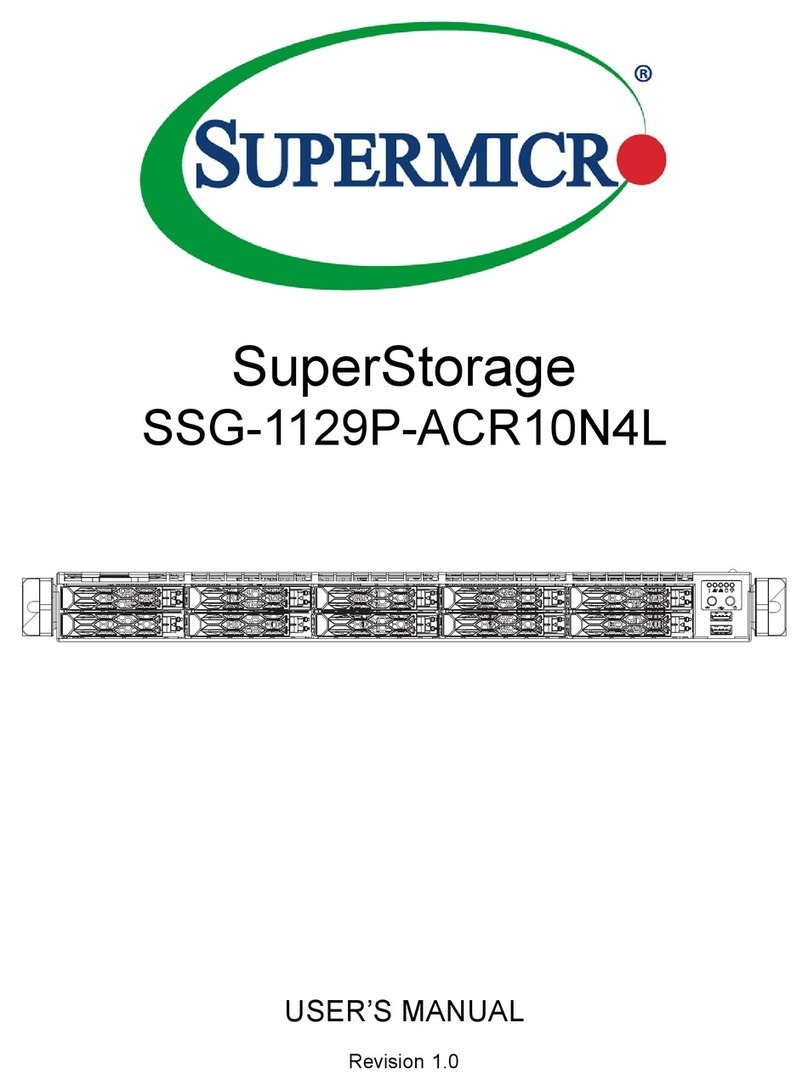
Supermicro
Supermicro SuperStorage SSG-1129P-ACR10N4L user manual
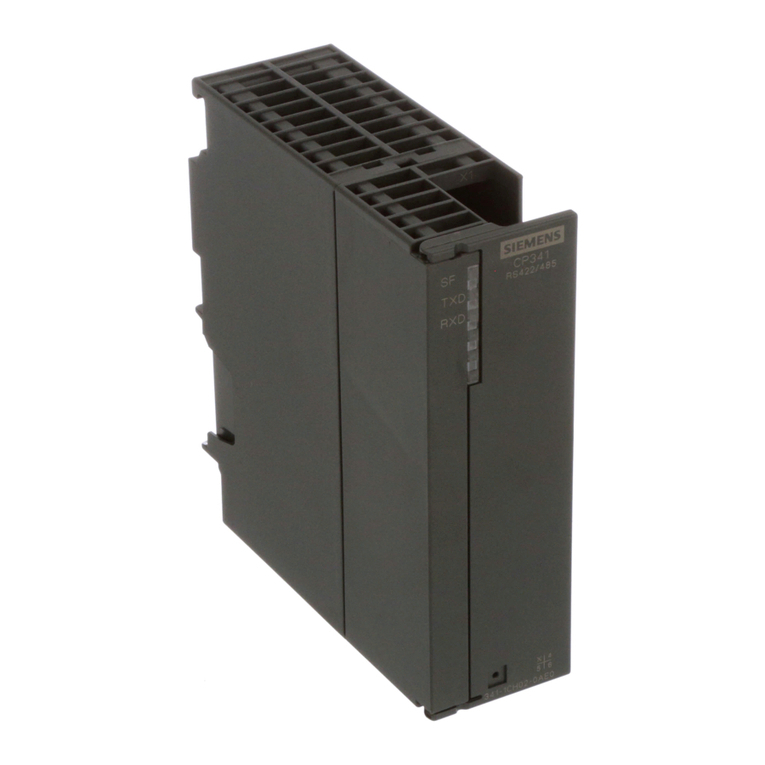
Siemens
Siemens SIMATIC CP 341 Getting started
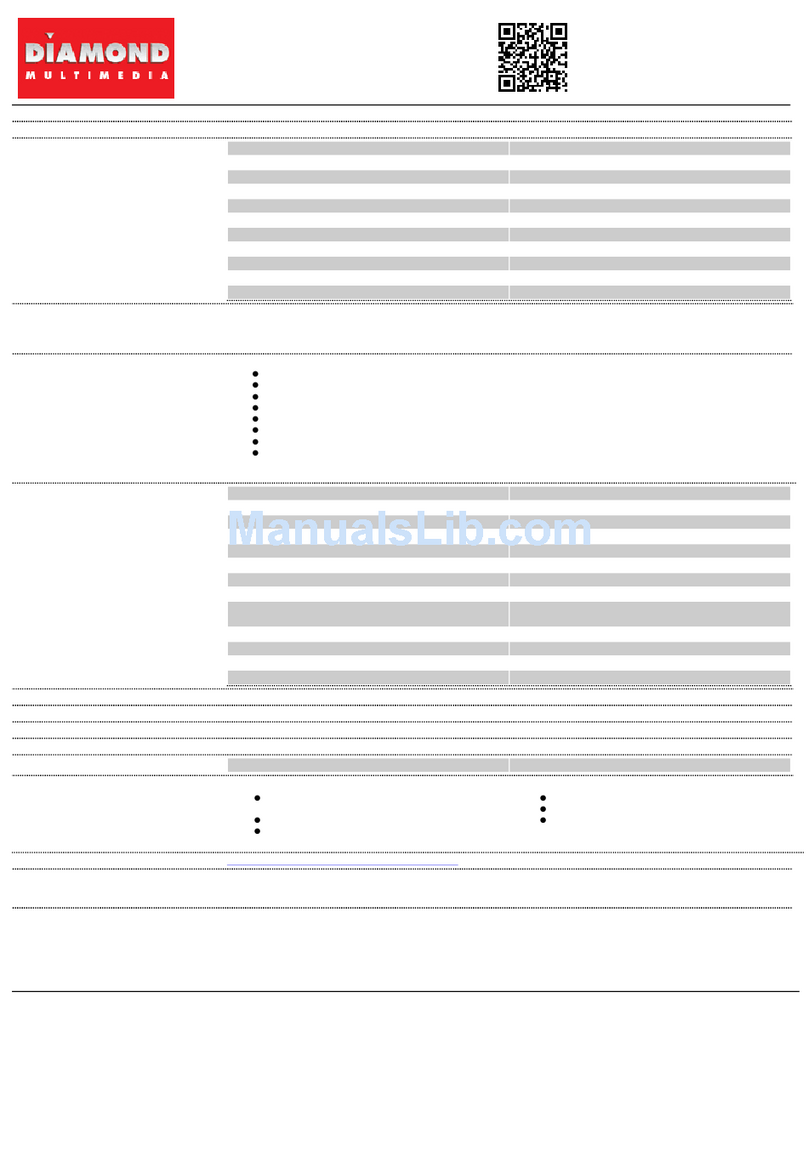
Diamond Multimedia
Diamond Multimedia 2400PRO256PE Specification sheet
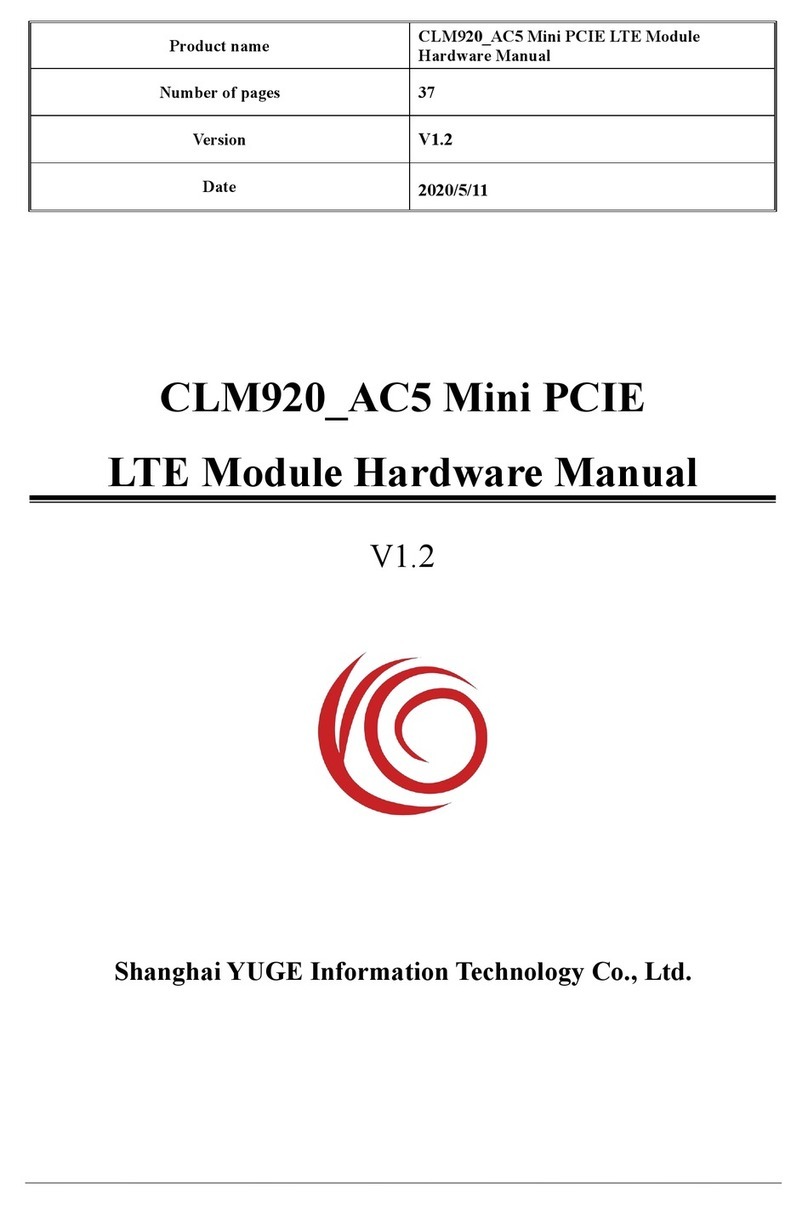
YUGE
YUGE CLM920 AC5 Hardware manual
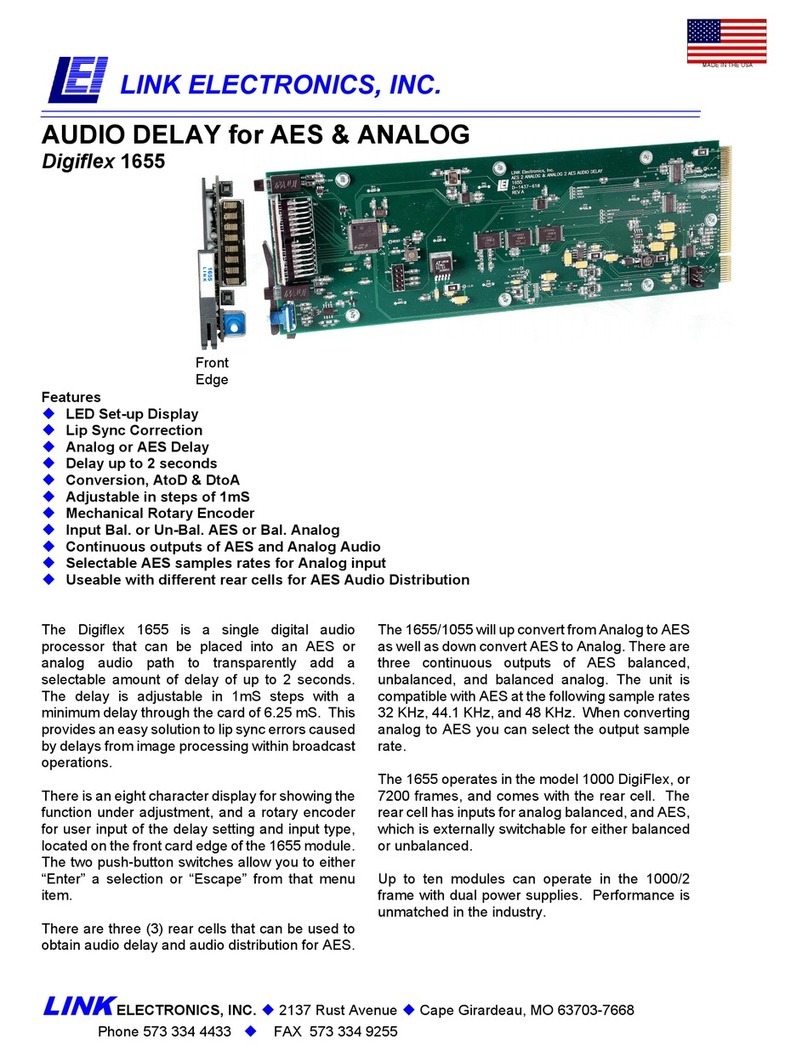
Link
Link Single Digital Audio Processor Digiflex 1655 Specifications
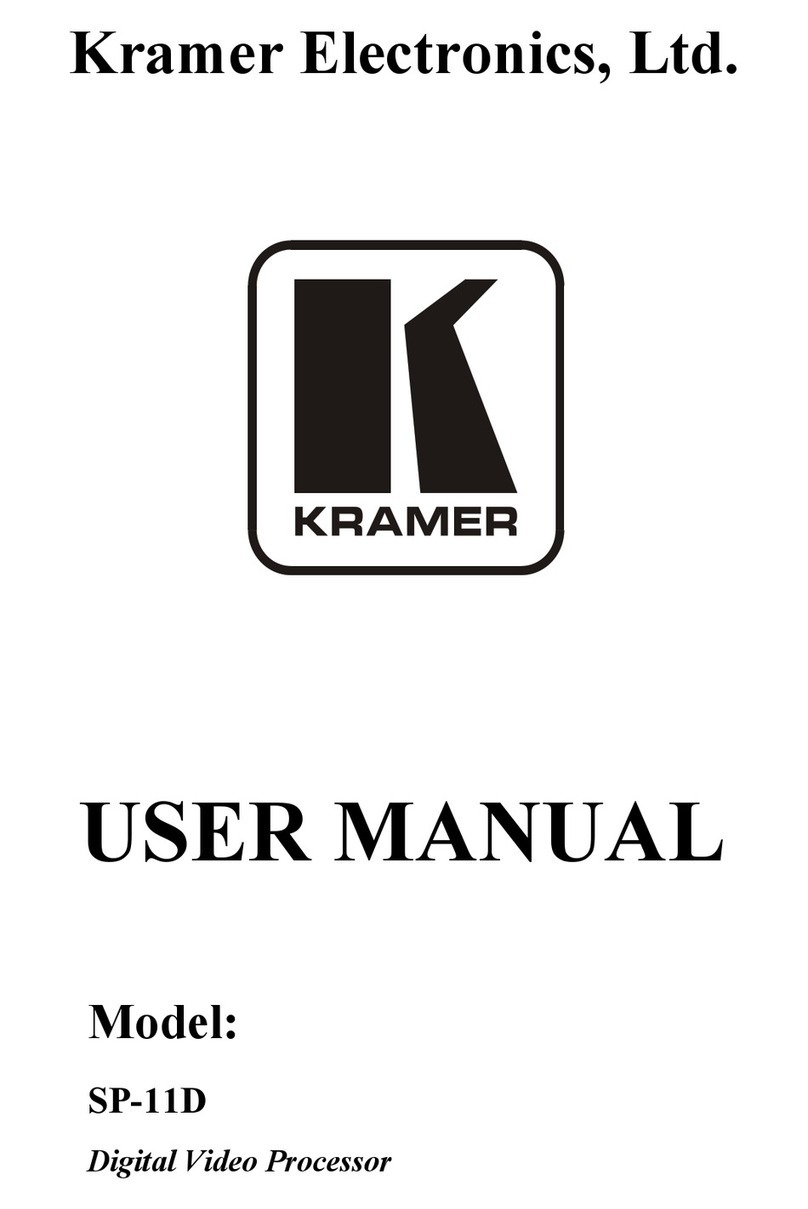
Kramer
Kramer SP-11D user manual
